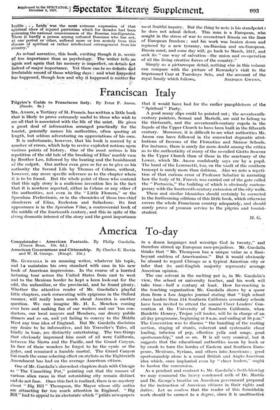Franciscan Italy
'Pilgrim's Guide to Franciscan Italy. By Peter F. Anson. (Sands. 13s.) Ma. ANSON, a Tertiary of St. Francis, has written a little book that is likely to prove extremely useful to those who wish to see all that is associated with the life of the saint. He gives a great deal of information arranged practically for the tourist, generally names his authorities, often quoting at length, but seldom adventuring on appreciations of his own.
It is unfortunate, however, that his book is marred by a number of errors, which help to revive exploded notions upon various points of history. One of the most serious is his repetition of the old tale of the breaking of Elias' marble vase by Brother Leo, followed by the beating and the banishment of the culprit. Our author even goes so far as to give as his authority the Second Life by Thomas of Celano, without, however, any more specific reference as to the chapter where it is to be found. But the whole point of those who contend story that this ugly sto- is a malicious invention lies in the fact that it is nowhere reported, either in Celano or any other of the authorities, not even in the " Little Flowers," or the Speculum Perfectionis, or in the chronicles of those two chief slanderers of Elias, Eccleston and Salimbene. Its first appearance is in the Speculum Vitae, a controversial book of the middle of the fourteenth century, and this in spite of the strong dramatic interest of the story and the great importance
that it would have had for the earlier pamphleteers of the " Spiritual " Party.
A good many slips could be pointed out ; the seventeenth- century painters, Sermei and Martelli, are said to belong to the thirteenth, and the seventeenth-century cupola in the façade of the Upper Church to have been built in the fifteenth century. Moreover, it is difficult to see what authorities Mr. Anson can have followed in the somewhat dogmatic attri- butions of frescoes of the Florentine and Sienese Schools. For instance, there is surely far more doubt among the critics as to the authenticity of many of the so-called Giotto frescoes in the Upper Church than of those in the sanctuary of the Lower, which Mr. Anson confidently says arc by a pupil. The hand of the Lorenzetti, too, on the vault of the southern transept is surely more than dubious. Also we note a repeti- tion of that curious error of Professor Sabatier in narrating how the body of St. Francis was carried out of the gate called the " Portaccia," the building of which is obviously contem- porary with the fourteenth-century extension of the city walls.
These and similar blemishes should certainly be corrected in the forthcoming editions of this little book, which otherwise covers the whole Franciscan country adequately, and should surely prove of yeoman service to the pilgrim and tourist- student.
II. G.










































































 Previous page
Previous page